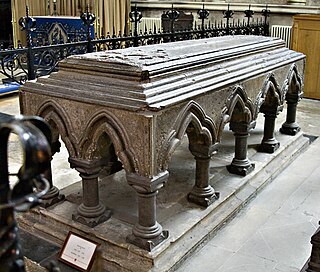Related Research Articles
Robert Winchelsey was an English Catholic theologian and Archbishop of Canterbury. He studied at the universities of Paris and Oxford, and later taught at both. Influenced by Thomas Aquinas, he was a scholastic theologian.
Robert of Ghent, also called Robert de Gant, was Lord Chancellor of England and Dean of York in the 12th century. The younger son of a nobleman, Robert was probably a member of the cathedral chapter of York before his selection as chancellor by King Stephen of England in the mid-1140s. He is not mentioned often in documents from his time as chancellor, but why this is so is unknown. He became dean at York Minster around 1147. Robert was slightly involved in the disputes over who would be Archbishop of York in the late 1140s and 1150s, but it is likely that his chancellorship prevented his deeper involvement in diocesan affairs. He was no longer chancellor after the death of Stephen, but probably continued to hold the office of dean until his death around 1157 or 1158.
Walter Giffard was Lord Chancellor of England and Archbishop of York.

Sewal de Bovil was a medieval Archbishop of York.

Godfrey Ludham was Archbishop of York from 1258 to 1265.
William de Wickwane was Archbishop of York between 1279 and 1285.
Thomas of Corbridge was Archbishop of York between 1299 and 1304.
William of St. Barbara or William of Ste Barbe was a medieval Bishop of Durham.
Roger Niger was a thirteenth-century cleric who became Bishop of London. He is also known as Saint Roger of Beeleigh.
Simon Langton was an English medieval clergyman who served as Archdeacon of Canterbury from 1227 until his death in 1248. He had previously been Archbishop-elect of York, but the election was quashed by Pope Innocent III.
William Langton was a medieval English priest and nephew of Archbishop Walter de Gray. William was selected but never consecrated as Archbishop of York and Bishop of Carlisle.
William of Bitton was a medieval English Bishop of Bath and Wells.
John of Greenford was a medieval Bishop of Chichester.
Seffrid II was an English cleric who served as a medieval Bishop of Chichester.

William of Louth, also known as William de Luda was a medieval Bishop of Ely.
Henry of Lexington was a medieval Bishop of Lincoln.
Richard de Belmeis was a medieval cleric, administrator and politician. His career culminated in election as Bishop of London in 1152. He was one of the founders of Lilleshall Abbey in Shropshire.
Burchard du Puiset was a medieval Anglo-Norman clergyman and treasurer of the diocese of York. Either the nephew or son of Hugh du Puiset, the Bishop of Durham, Burchard held a number of offices in the dioceses of York and Durham before being appointed treasurer by King Richard I of England in 1189. His appointment was opposed by the newly appointed Archbishop Geoffrey, which led to a long dispute between Geoffrey and Burchard that was not resolved until the mid 1190s. After the death of Hugh du Puiset, Burchard was a candidate for the Hugh's old bishopric, but lost out in the end to another candidate. Burchard died in 1196.
Hamo was a 12th- and 13th-century English cleric. He was the Diocese of York's dean, treasurer, and precentor, as well as the archdeacon of the East Riding. His background is unknown, but he was probably a canon of the cathedral chapter at York Minster by 1171. He claimed to have been treasurer of the chapter by 1189, but did not actually hold the office until 1199. Hamo clashed with his archbishop, Geoffrey several times, and when Geoffrey died, Hamo's fellow canons were forbidden by King John of England from electing Hamo to succeed Geoffrey. Hamo died sometime after 1219, when he was last attested as holding his final office, dean.
Hugh Murdac was an English clergyman and canon of York Minster in the 12th and 13th centuries.
References
- Fryde, E. B.; Greenway, D. E.; Porter, S.; Roy, I. (1996). Handbook of British Chronology (Third revised ed.). Cambridge, UK: Cambridge University Press. ISBN 0-521-56350-X.
- Greenway, Diana E. (1999). "Archbishops". Fasti Ecclesiae Anglicanae 1066–1300. Vol. 6: York. Institute of Historical Research. Archived from the original on 7 June 2007. Retrieved 22 September 2007.
- Greenway, Diana E. (1999). "Archdeacons: Richmond". Fasti Ecclesiae Anglicanae 1066–1300. Vol. 6: York. Institute of Historical Research. Retrieved 22 September 2007.
- Greenway, Diana E. (1999). "Deans". Fasti Ecclesiae Anglicanae 1066–1300. Vol. 6: York. Institute of Historical Research. Archived from the original on 28 September 2007. Retrieved 22 September 2007.
- Smith, David M. (2004). "Newark, Henry of (d. 1299)". Oxford Dictionary of National Biography. Oxford University Press. doi:10.1093/ref:odnb/19975.(subscription or UK public library membership required)